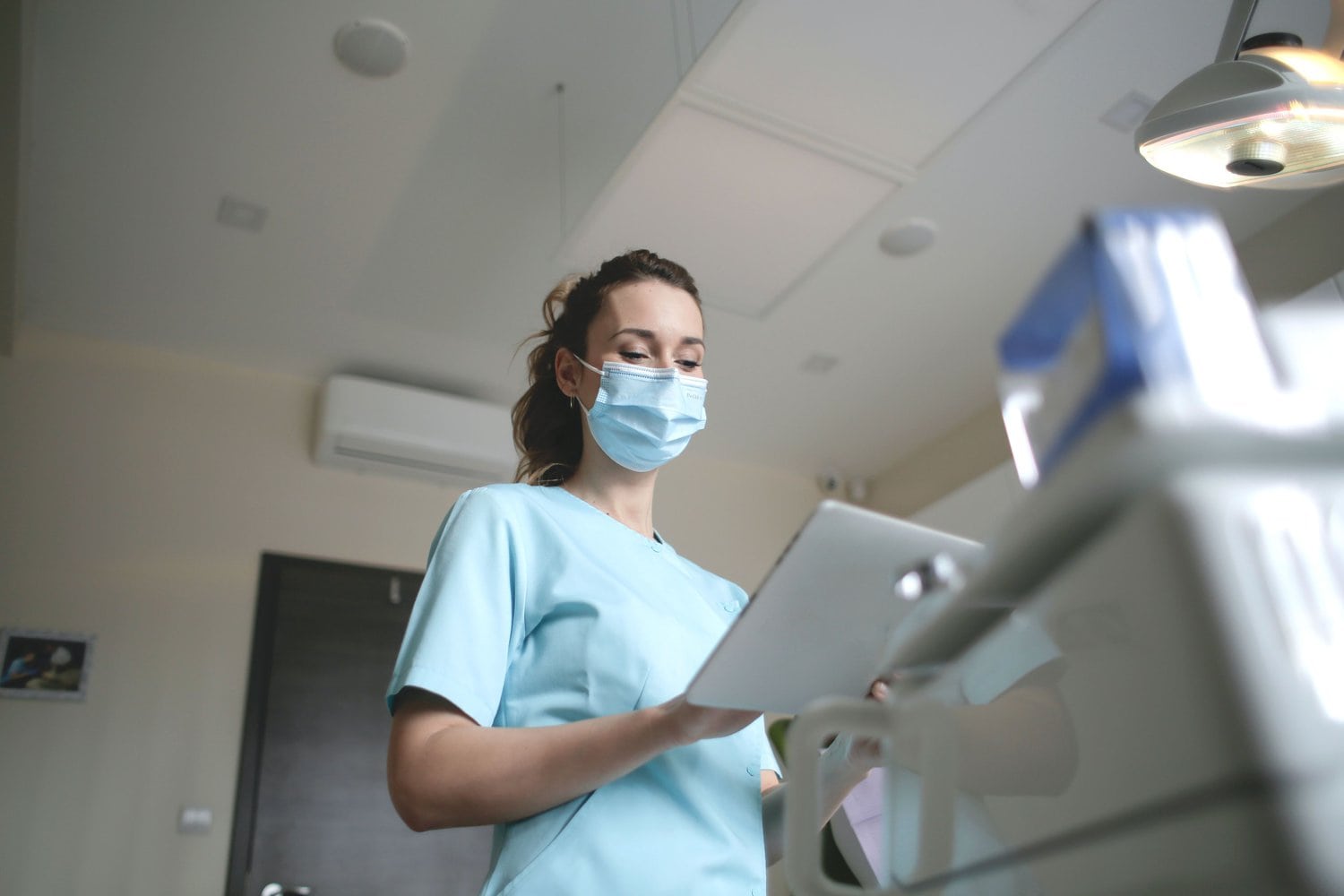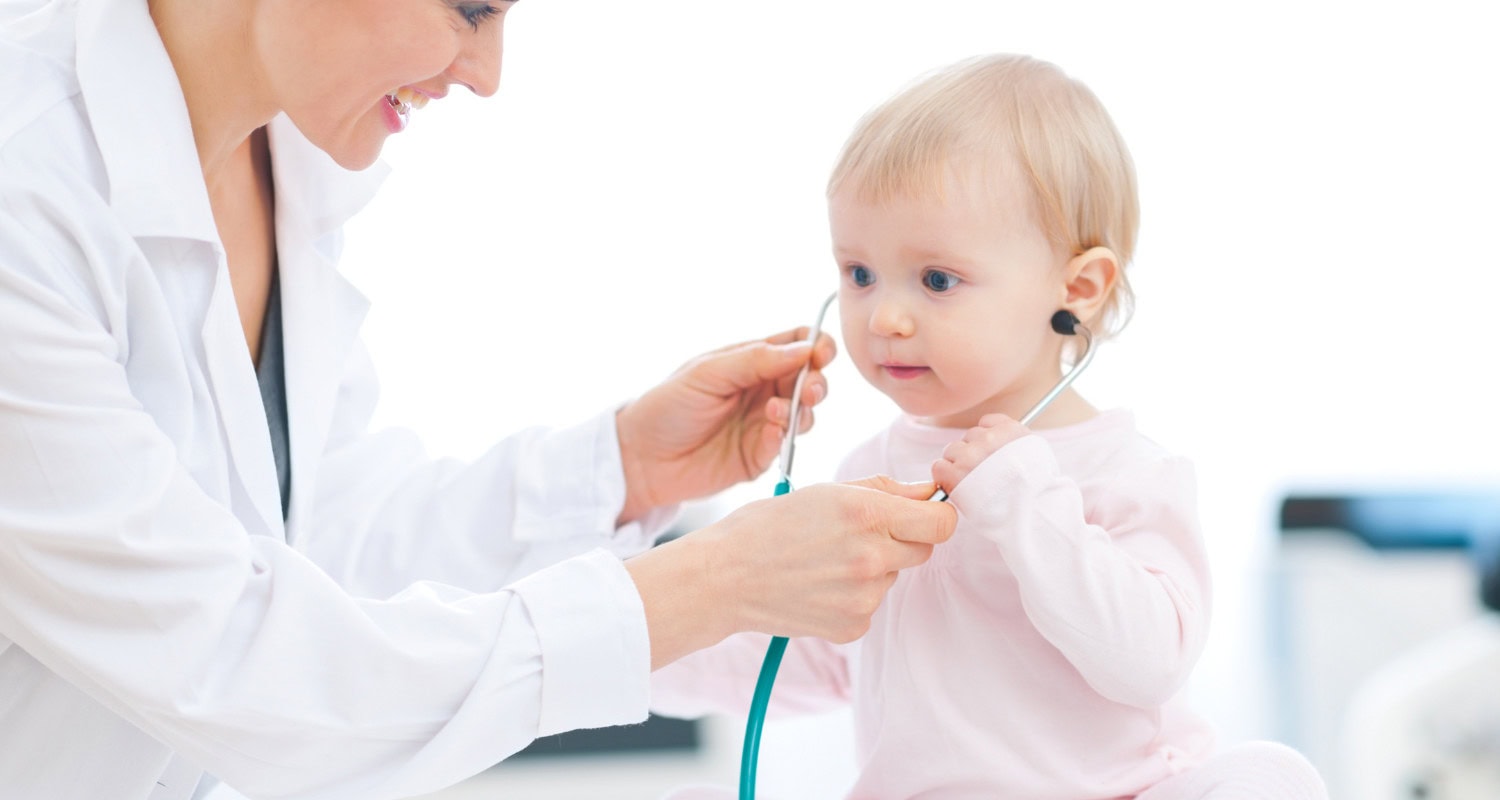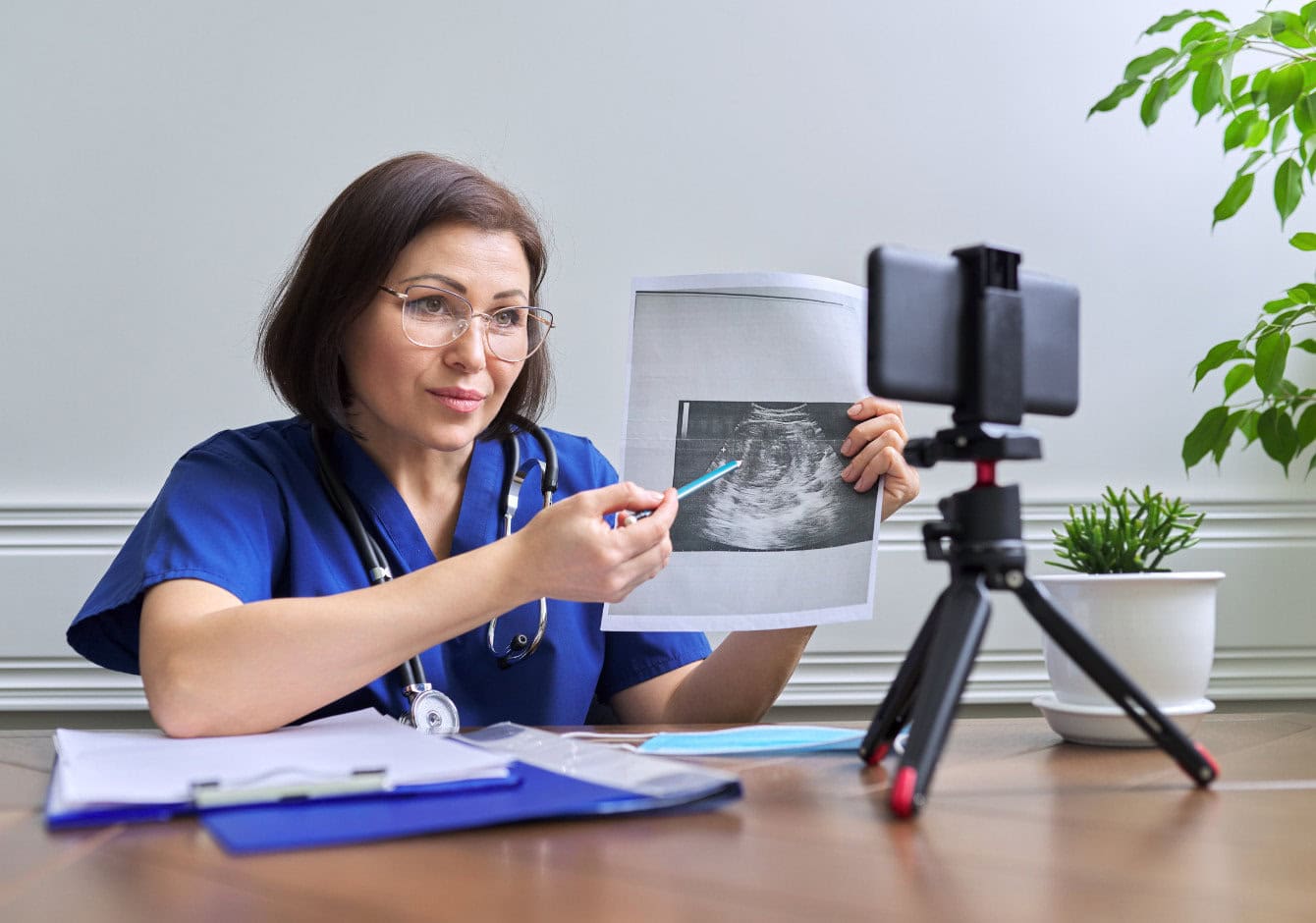A few decades ago, small devices implanted into a human body could only be seen in movies like Terminator. Now, telemetry and remote cardiac monitoring solutions are widely used across US hospitals to improve the quality of care and save the lives of thousands of patients with various heart pathologies.
For example, for chronic heart conditions, you can use smart remote cardiac monitoring devices to monitor patients’ heart rhythms and manage arrhythmia symptoms. Patients with heart surgery need implanted cardiac devices to ensure their recovery is on track and minimize in-person visits, which can be disturbing for post-operative individuals.
Learn more about cardiac remote monitoring benefits for patients and healthcare professionals, recent research on remote cardiac monitors’ efficiency, and the core components of cardiac remote systems in our blog post.
What is Remote Cardiac Monitoring?
A remote cardiac monitoring solution allows medical specialists to check the indicators of implantable cardiac devices even when the patient is miles away. RPM tools can monitor heart rates, blood pressure, and rhythm disturbances by transmitting information from the implanted device or EEG recorders to the doctor’s office and the electronic healthcare system without direct in-person interaction.
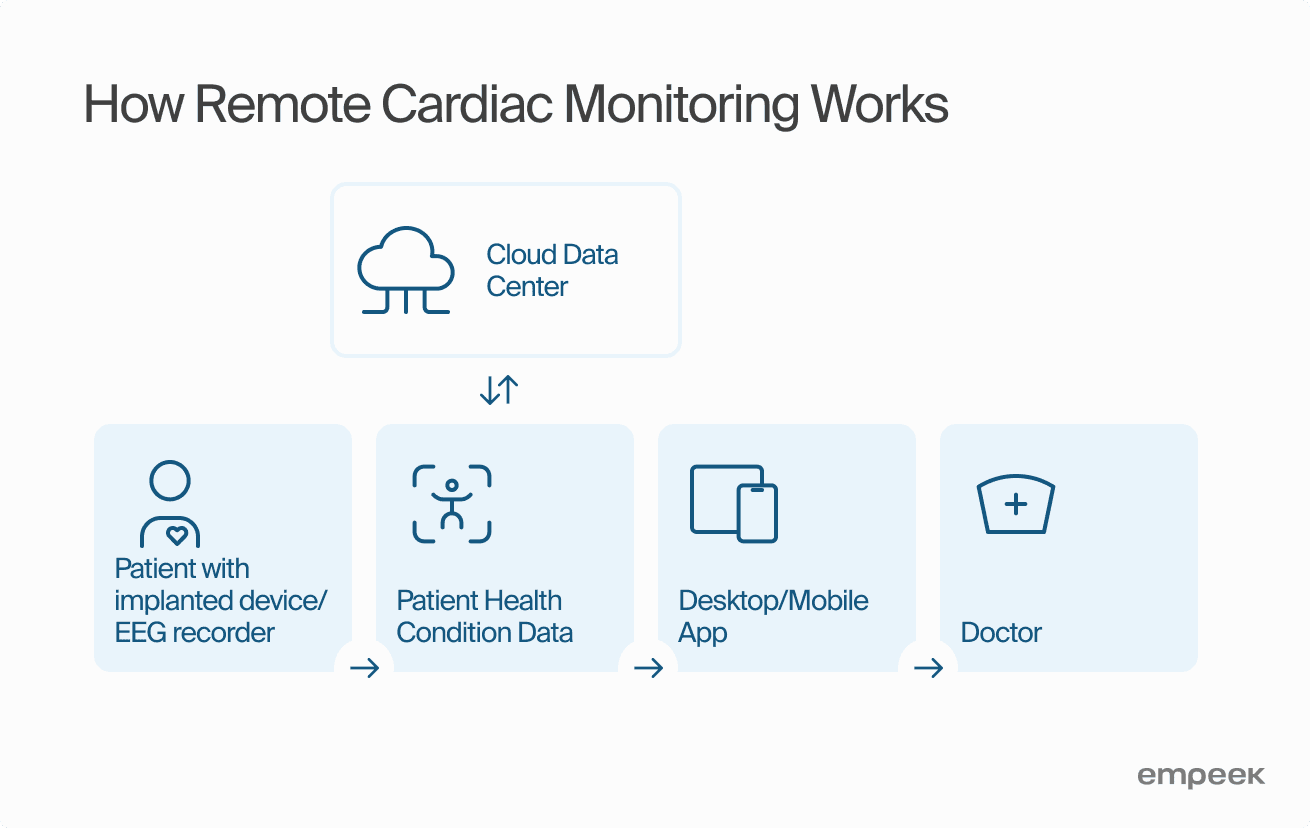
Think of it as an analogy to controlling your iPhone using your MacBook or any Apple computer.
- You can access the indicators displayed by the pacemakers or other cardiac implantable electronic devices (CIEDs) just like you can view the phone’s performance on your laptop;
- You can check the battery life of the CIED and see if it needs maintenance or replacement the same way you monitor your smartphone’s battery life;
- Remote heart monitoring systems allow doctors to configure certain features in the device or app without the need for a patient’s visit, just like how you can configure your phone from your computer;
- Similar to a phone-laptop pairing, the synchronization between a pacemaker and pacemaker monitoring devices is possible via compatible software that allows remote data transmission.
In the meantime, unlike the case with the phone and laptop, the outcomes of using wireless medical monitoring for CIEDs patients aren’t just convenience and speed – in some cases, RMP tools can become a life-saving solution and bring various advantages to patients and doctors. So, what are the other benefits of remote cardiac monitoring and remote cardiac services?
Read Overview of Health Monitoring Devices
Benefits of Remote Cardiac Monitoring: Patients’ and Doctors’ Perspectives
Even though remote patient monitoring remains underutilized in modern medical practice, remote telecardiology services show many benefits for both care providers and patients. Recent research proved implantable CIEDs significantly improve patient care with the following key findings:
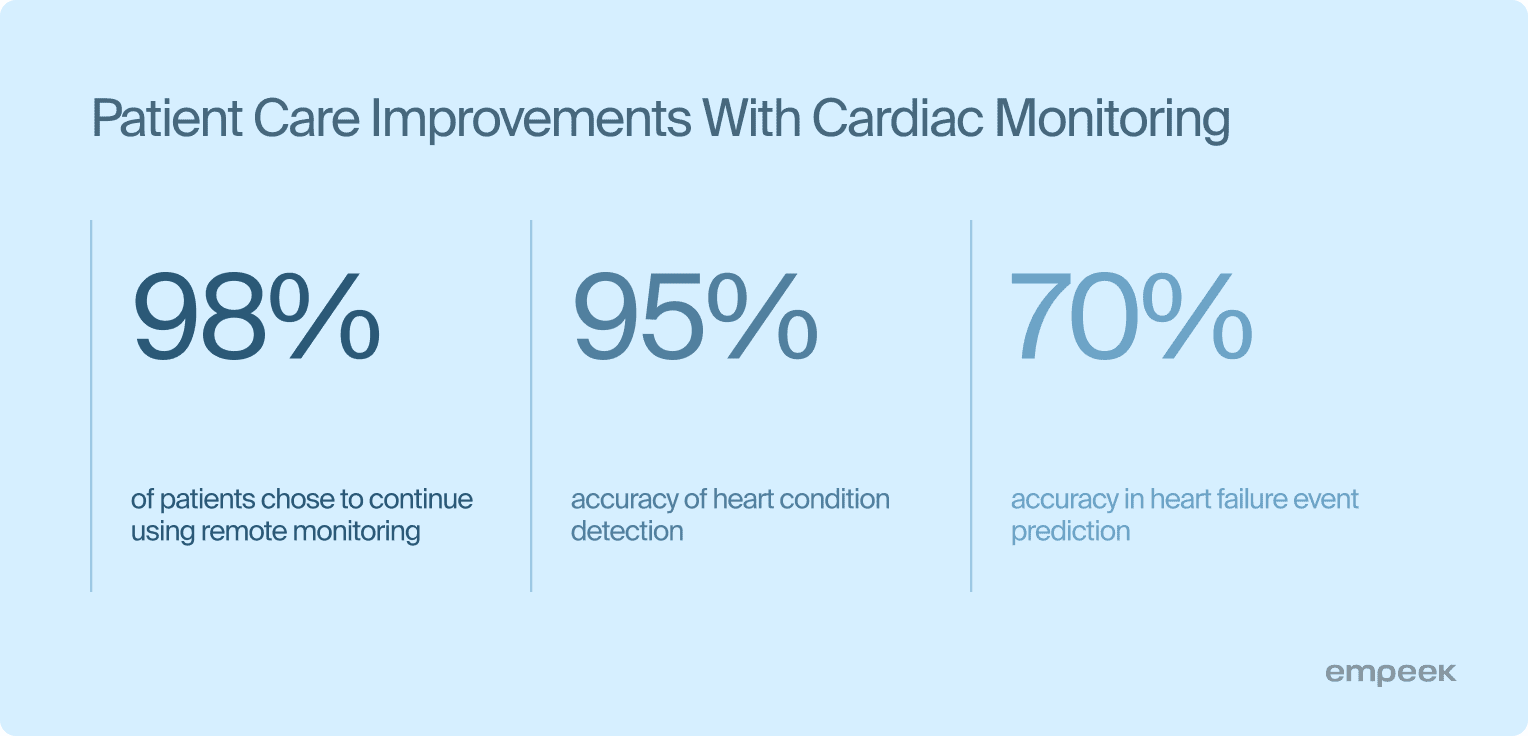
Remote Patient Monitoring Advantages for Physicians
Technology-driven innovation in cardiac remote patient monitoring allows providers to stay ahead of the competition. Healthcare facilities offering remote cardiac services are more likely to increase customer satisfaction with treatment, which leads to improved reputation and more clients.
Hospitals equipped with cardiac remote monitoring devices detect patients in critical conditions faster and prioritize their treatment. Also, they can predict pathology development and take preventive measures before heart failure occurs, among other benefits.
Improved triage management
When deciding who requires more urgent care, doctors must be well-equipped with the tools to help them make an evidence-based decision. By using pacemaker monitors to examine patients with CIEDs or devices to detect heart attacks, doctors can decide which patients are their first priority based on health indicators. This, in turn, can prevent casualties and potential heart failure.
More personalized treatment plans
Preventing a disease always costs less than curing one. In the US, care for patients with heart conditions costs approximately $214 billion per year, with another $137 billion for lost productivity, totaling $351 billion annually. However, physicians cannot come up with effective disease prevention solutions unless they have enough data collected. Here’s where remote ECG monitoring systems come in. Remote monitoring devices collect and keep patient data that helps doctors assess the risks of developing pathologies or detect the need for a more detailed patient screening.
“Clinicians can strengthen their relationships with, and improve the experience of, their patients by using the data sent to them via RPM to develop a personalized care plan and to engage in joint decision-making to foster better outcomes.”
American Heart Association (AHA)
Increased healthcare service quality
Patient satisfaction influences healthcare facilities’ reputation, the number of patients, the number of lawsuits filed by unsatisfied clients, and, consequently, the total revenue. Remote monitoring, like a heart attack detection device, can predict many cases of the worsening of heart failure condition, which allows healthcare teams to manage such patients in outpatient care if identified early. As a result, patients won’t need hospitalization, while their vital signs are constantly monitored in the comfort of their homes. By adopting new technologies that help physicians improve the quality of services, healthcare providers can enhance patient outcomes and establish trustful relationships with patients.
Advantages of Telemetry Monitoring for Patients
While remote health monitoring helps doctors assess the patient’s condition and provide better care, it also brings multiple benefits to patients. With remote ECG monitoring systems, patients can get more involved in self-care routines, save time and money on excessive doctor visits, and become more mobile.
Early detection of cardiac events
Cardiac monitoring devices use medical sensors to measure electroencephalograms (EEG), ECG, glucose levels, temperature, and other indicators that allow immediate detection of any anomalies. The device sends the collected data to a provider’s server for processing. If there are any unusual signs, the server transfers the data to another software system to identify whether the physicians need to take any actions. With early detection, patients have more chances to receive timely treatment that can potentially save their lives.
Enhanced mobility and reduced need for hospitalization
Mobile cardiac telemetry devices allow patients to have their heart indicators monitored while staying at home. These devices provide continuous vital sign tracking, reducing the need for frequent hospital visits. They enhance patient mobility and ensure timely detection of cardiac issues while patients aren’t tied to the medical facility for heart condition management.
Time and money saving option
Using remote cardiac monitoring devices, including EEG, ECG, CIEDs, wearables, pulse oximeters, pacemakers, and blood pressure trackers, patients can cut healthcare costs. Remote monitoring of heart conditions allows patients to avoid paying for hospital and ER stays, especially for individuals with chronic heart diseases who are prone to readmissions.
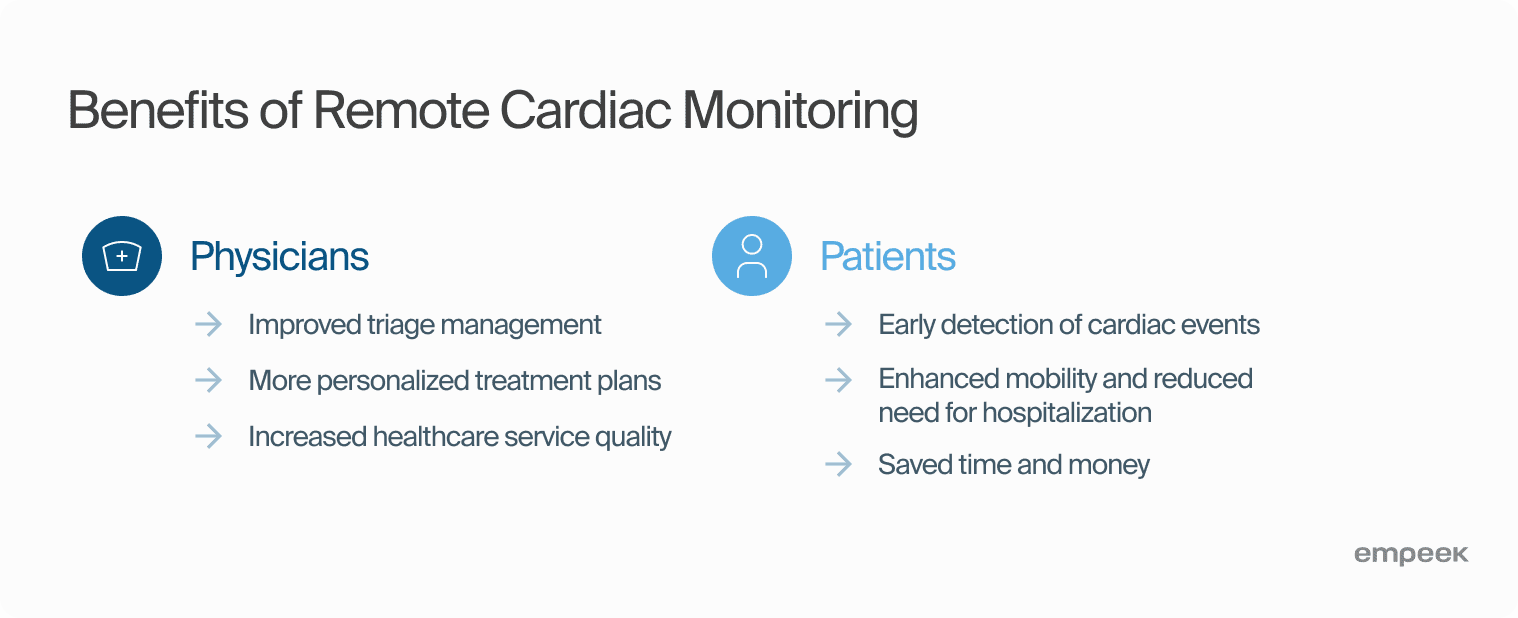
As you can see, the remote cardiac care option is extremely beneficial to providers and receivers of medical aid. One of the core benefits of remote patient monitoring cardiology is the early detection of symptoms that alert physicians about heart condition worsening. Patients can continue their lives without discomfort while their cardiac health is monitored in real-time. Additionally, cardiac remote devices help reduce costs spent on readmissions, hospital stays, and frequent checkups within the medical facility.
Latest Research on the Efficiency of Cardiac Remote Monitoring
Cardiac remote monitoring has been the focus of many studies lately. Researchers have analyzed the efficiency of cardiac devices and their impact on patients’ health for more data-driven and effective treatment choices.
One of the studies found that remote echocardiography monitoring and consultations significantly reduced the overall treatment process time from an average of 114 days to 27 days. Patients had doctor appointments much faster, taking, on average, 12 days compared to 86 days with traditional methods. The research also showed that out of 19 patients who had remote monitoring and consultations, 89% responded positively and felt that robotic echocardiography was as good as a standard ultrasound. 95% of patients believed they received faster care with remote monitoring than traditional methods. They thought remote monitoring and consultations were better because they didn’t need to travel, received quicker diagnosis, and expected faster treatment.
In another study, researchers monitored remote care (RC) patients and standard care (SC) patients with cardiac diseases throughout the year to determine which treatment type ensures better outcomes. The monitoring of the RC group included such devices as implantable cardioverter-defibrillators (ICD) and cardiac resynchronization therapy with defibrillator (CRT-D) devices. They discovered a significant difference in hospitalization and all-cause death levels between the two groups of patients, which was 48.5% within the SC group and 39.5% within the RC group. Moreover, only 37.1% of RC group patients have been hospitalized in comparison to 45.5% of SC group patients. The scientists concluded that remote care for patients with cardiac diseases decreased hospitalization and all-cause mortality levels.
The study of remote monitoring (RM) efficiency with cardiac implantable electronic devices showed that RM can detect atrial fibrillation (AF) 1 to 5 months earlier than standard follow-ups with about 95% accuracy. In 94% of cases, cardiac remote monitoring replaced checkups within the healthcare facility, saving patient and provider costs. Nearly 90% of the AF episodes don’t show any symptoms. Detecting AF early means treatment can start sooner, which may prevent serious health issues like heart failure and strokes. Patients who participated in ECG remote monitoring had a 44% lower chance of dying. With RM, systematic checkups are more convenient than in-hospital appointments.
| Research subject | Authors | Findings |
|---|---|---|
| Time to diagnosis comparing standard care and remote care processes for echocardiographic examination | Kurt Boman, Mona Olofsson, Peter Berggren, Partho P. Sengupta, Jagat Narula | Reduction of treatment process time from an average of 114 days to 27 days, faster diagnosis, and positive patient reaction to remote monitoring (Source) |
| Hospitalization rates research with patients having implanted cardioverter-defibrillator | Mateusz Tajstra, et al. | Remote care for cardiac patients demonstrated less hospital admissions and all-cause mortality rates (37.1% in comparison to 45.5% for the standard care group) (Source) |
| Treatment management via remote monitoring of cardiac implantable electronic devices (CIEDs) | Niraj Varma, et al. | Earlier detection of atrial fibrillation (AF) with remote monitoring reaches 95% accuracy (Source) |
| Cardiac remote monitoring and its influence on treatment time and costs | Alberto Preda, et al. | Remote monitoring saves time and budgets for patients and healthcare providers without causing any safety issues. 94% of planned health examinations could be managed via remote systems. (Source) |
| The impact of cardiac remote monitoring on mortality rates | Vittorio Masotta, et al. | Cardiac telemonitoring reduced mortality rates by 44% and allowed for timely patient coaching (Source) |
Cardiac Remote Monitoring Companies and Solutions They Offer
Cardiac remote monitoring devices vary to measure different heart-related health metrics and detect potential issues early on. Blood pressure cuffs measure and track blood pressure levels, a must-have indicator to track hypertension and other cardiovascular conditions. Pulse oximeters monitor oxygen and pulse levels. Remote ECGs record and transmit electrocardiogram data, which helps physicians detect arrhythmias and other heart diseases in real time. Pacemakers are implanted devices that regulate heartbeats. Other implantable cardiac devices are heart monitors and defibrillators that send data remotely to healthcare providers.
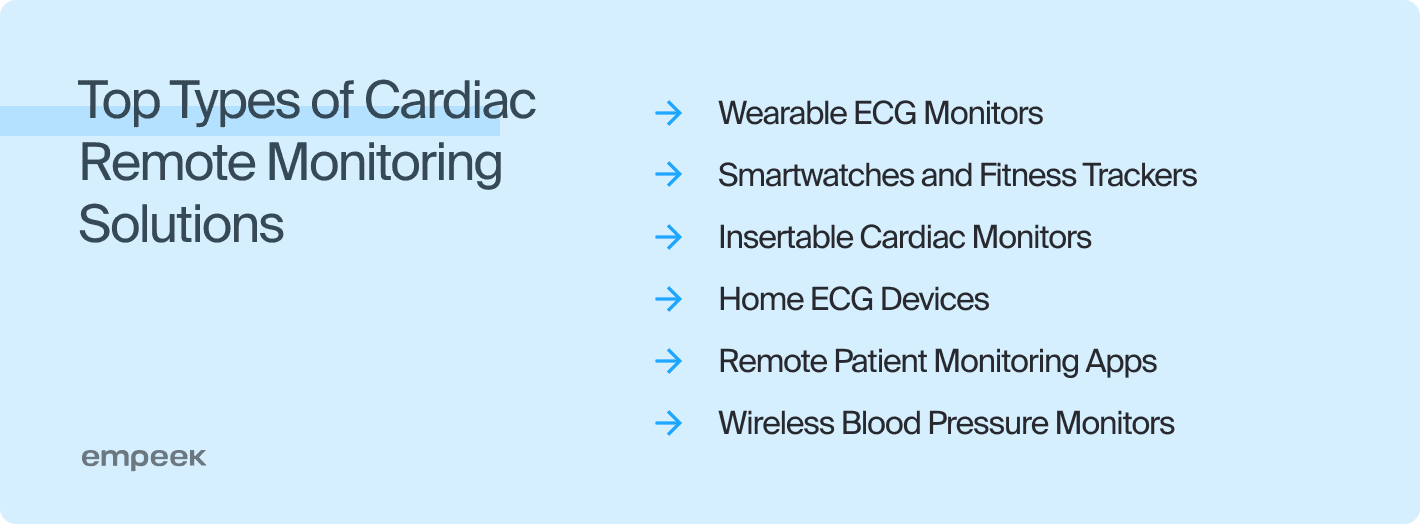
Continuous cardiac monitoring is indispensable without these devices and specific remote platforms that enable patient-physician communication and proper disease management. Learn what software options from top remote cardiac monitoring companies are available in the market below.
Medtronic
Medtronic is an American healthcare technology provider that develops cardiac solutions for remote monitoring. Their LINQ II insertable cardiac monitor (ICM) is designed for long-term symptom tracking. The device uses advanced algorithms, such as Atrial Fibrillation (AF) and Pause AccuRhythm AI, to improve output accuracy. Their cloud-based AI system minimizes false alerts, allowing healthcare providers to focus more on patient care.
Core capabilities of the cardiac remote monitoring solution:
- Enhanced accuracy
Advanced AI algorithms filter false alerts to increase diagnostics reliability. - Deep learning integration
Deep learning algorithms within the software trained on large ECG databases to avoid data bias. - High-risk detection
The smart detector of premature ventricular contractions (PVC) helps spot high-risk patients. - Secure and stable communication
Bluetooth low energy (BLE) ensures safe, wireless communication and doesn’t drain the battery as less effective communication protocols. - Remote access
Caregivers can check a patient’s ECGs remotely, which reduces manual work.
Vivify Health
Vivify Health is a Texas-based company offering a Remote Patient Monitoring (RPM) system that includes their proprietary software, third-party biometric devices, and the Care Team Portal. Patients can report symptoms and other health-related information, enabling medical experts to help with their health conditions.
Core capabilities of the cardiac remote monitoring solution:
- +Home Kit
A user-friendly package with a step-by-step guide and a dedicated expert to help resolve any difficulties with the kit. - Delivery tracking
The software supports delivery monitoring to confirm that patients receive the packages. - EMR integrations
Vivify Health’s software seamlessly integrates with various Electronic Medical Records (EMR) systems. - Enhanced communication
Video calls and in-app texting enable communication between doctors and patients.
Rimidi
Rimidi, a US-based company, has developed an FHIR-enabled platform for remote patient monitoring, including monitoring of patients with cardiovascular diseases, HF, and hypertension. The RPM system integrates patient health information from different devices, including scales, glucose trackers, and blood pressure cuffs. It also connects to Electronic Medical Records for improved chronic disease treatment.
Core capabilities of the cardiac remote monitoring solution:
- Multiple use cases. Healthcare providers can adapt the platform to various chronic conditions and monitoring needs.
- FHIR and HL7 APIs implementation. Seamlessly integrates with major EMRs using standardized APIs for improved healthcare device and software interoperability.
- Improved connectivity. Rimidi’s software supports external APIs, like those used within cellular devices and Bluetooth.
- Actionable data connections. Links patient data and clinical data to provide unique insights on each patient.
- Clinical decision help. The software offers specific support cards that provide necessary information to help make clinical decisions.
Current Health
Current Health, operating in the UK and the USA, has developed a platform for agile remote patient monitoring with a company’s proprietary wearable and cardiac connectivity devices. This platform ensures FDA-cleared, safe monitoring of five key health indicators through a bespoke wearable device. Patients receive a pre-configured kit that is easy to set up right away.
Core capabilities of the cardiac remote monitoring solution:
- Reminders
The platform facilitates condition management for patients through regular engagement with the kit. - Integration with monitoring devices
The system connects to a wide variety of devices for vital sign tracking. - Questionnaires
Medical professionals can gather information about the patient’s condition and lifestyle to implement necessary changes in clinical decision-making. - Video checkups
The platform facilitates communication by enabling video consultations to make sure patients receive proper treatment and coaching. - Messaging within the platform
The system enables a responsible care team to communicate with patients for continuous disease management and treatment.
Kencor Health
Kencor Health is an American company providing remote chronic care management for cardiology patients. Their platform, SAMi, combines patient monitoring through various wearables, virtual check-ins, and reminders to ensure patient adherence to treatment plans.
Core сapabilities of the cardiac remote monitoring solution:
- Integrated patient monitoring devices
Kencor provides a home measurement kit for patients to monitor their vital signs, such as blood pressure and heart rate, which are wirelessly transmitted to the patient’s profile for easy access by physicians. - Daily patient data analysis
The platform evaluates and analyzes patient-generated data, creating a list of critical patients for physician review with color-coded indicators for easy prioritization. - Remote care plan adherence
Kencor’s solution monitors patient adherence to prescribed care plans, offering physicians insight into patient progress and enabling timely interventions. - Intuitive dashboard design
Each platform user can easily navigate through functionality, which is especially useful for elderly patients or events that require immediate physician help. - Virtual check-ins and reminders
The platform supports ongoing virtual consultations and sends medication reminders to ensure patients stay on track with their treatment.
Off-the-shelf solutions by cardiac remote monitoring companies offer diverse functions that match multiple healthcare provider requirements for home-based continuous monitoring, such as effective communication protocols and compatibility with specific devices. However, their features are limited to specific metrics, devices, and patient groups. Custom cardiac software development can significantly expand the number and types of devices providers can connect to their platform. Moreover, providers will have more freedom in choosing the design of the platform and features to meet patients’ and physicians’ needs.
Things to Consider When Integrating Cardiac Remote Patient Monitoring
Remote cardiac monitoring is a complex HIPAA-compliant system the implementation of which requires careful planning and a step-by-step approach. Such solutions usually include an admin dashboard to manage user access, schedules, and requests, a physician app that provides data from devices and alerts, a patient app displaying vital signs and notifications, cardiac devices for data collection and transmission, and a cloud server for processing and data analysis.
You must ensure all the components work smoothly while the system is reliable, secure, and convenient.
A well-designed RPM solution for cardiac care ticks all the following boxes:
- User-friendliness and accessibility
A cardiac health monitoring system must have a clear interface and easy navigation since heart diseases require time-sensitive management; - Interoperability and integration
All system components must be compatible and follow the same standards like FHIR and HL7 for reliable data transmission and additional future integrations; - Data accuracy and patient safety
Communication protocols in cardiac remote monitoring platforms must ensure the accuracy and security of data collection for reliable healthcare services; - Data privacy
The solution must include access management, data encryption, regular OTA updates and security patches, authentication for all end users, as well as patient-controlled settings. - Scalability of the infrastructure
The solution must allow you to adapt to an increasing number of connected devices and users without compromising performance. - Regulatory compliance
The platform must adhere to all relevant state regulations to ensure legal compliance and protect patient information (e.g., HIPAA, GDPR and ISO 13485)
Cardiac remote patient monitoring platforms must offer accessible and intuitive dashboard design, interoperability, and scalability for easy device integration, data privacy, and compliance with specific state healthcare regulations. Collaborating with a tech vendor can facilitate the development and integration of such solutions. A third-party engineering provider will analyze your business and tech needs and help make cardiac remote monitoring a part of your services.
Remote Cardiac Monitoring Devices by Empeek
The Empeek team has expertise in building custom remote cardiac monitor systems. Our product development includes the discovery phase, PoC development, the creation of functional prototypes, and MVP development for market validation. Learn more about our experience with remote cardiac monitoring devices from the cases below.
AI-powered Heart Monitoring
Our engineers developed an AI-powered system that enhances real-time heart monitoring with minimal human intervention. Our neural network system is based on the expertise of cardiologists and a large set of heart rate data. This system reviews and filters out false heart issue warnings with automated data classification and recognition. Its AI capabilities can automatically classify heart problems with high accuracy, reducing the need for human intervention.
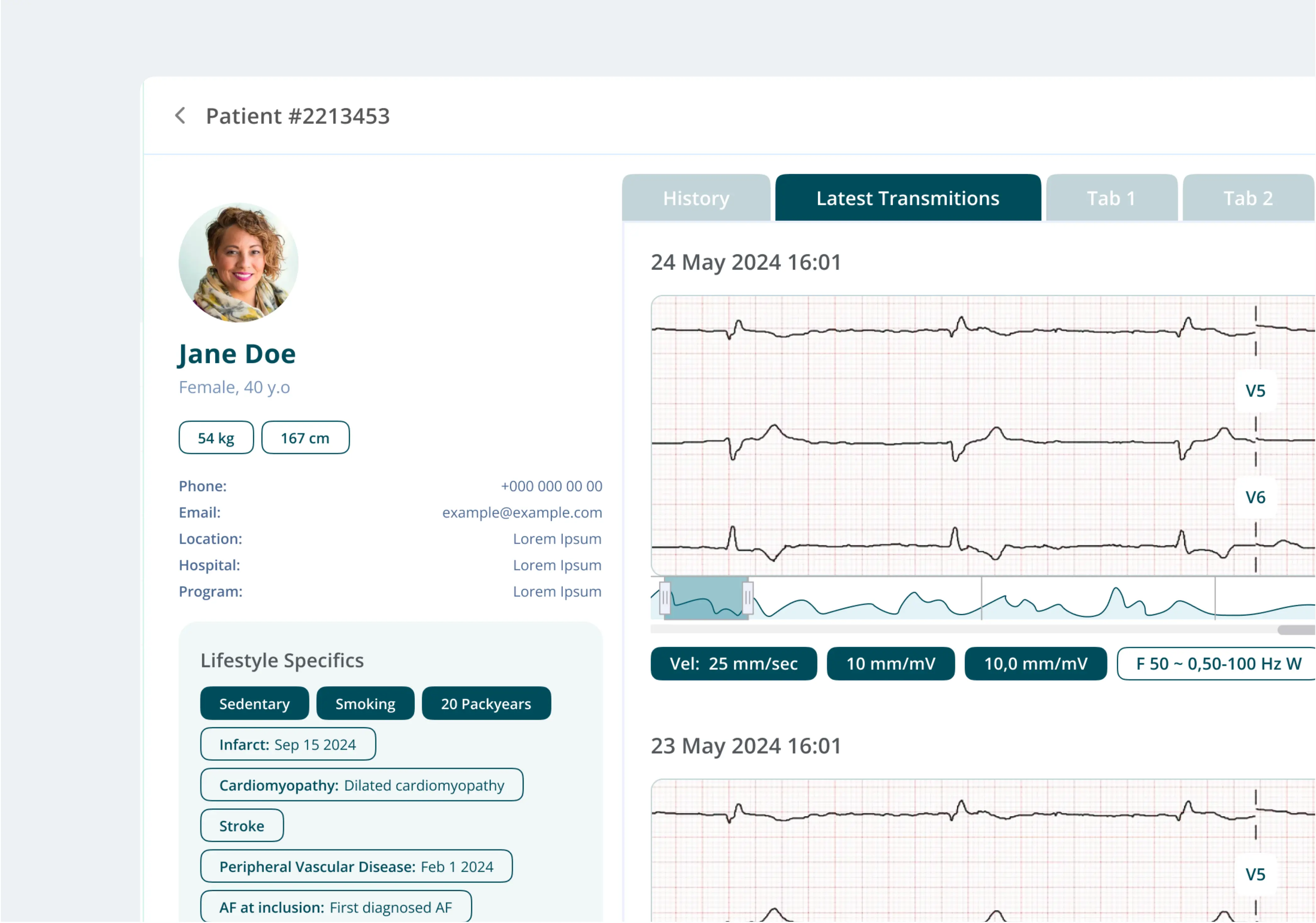
Remote Cardiac Monitoring System with a Wireless Heart Monitoring Device
Empeek engineers developed an advanced mobile cardiac telemetry system with a mobile app and ECG patch for real-time heart health monitoring. Our solution allows healthcare professionals to track the vital signs of thousands of patients simultaneously and prevent life-threatening events. We’ve provided our client with a scalable architecture, a cloud portal for 24/7 support, and an Android app compatible with a portable ECG device. In addition to heart rate, the platform monitors ECG, SCO2, activity level, and temperature.
Final Thoughts
Implementing remote monitoring solutions for cardiac care transforms the quality of healthcare services in many ways. Cardiac remote monitoring decreases hospitalization and mortality rates among patients with heart conditions. Cardiac remote solutions also cut treatment costs and time. For instance, a wearable heart attack monitor can immediately transfer patients’ symptoms to doctors who can intervene and prevent a heart attack before it’s too late.
The Empeek team has the relevant expertise in outsourced medical device development, creating fully custom software that performs precise remote patient monitoring for cardiac care management, complies with the laws, improves the outcomes of CIEDs patients, and increases the service quality of the medical provider.
Contact us to learn how our custom software can help you deliver superior patient care and work more efficiently.

